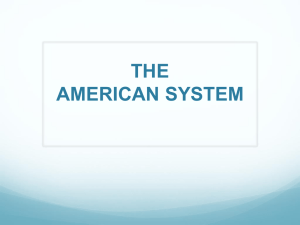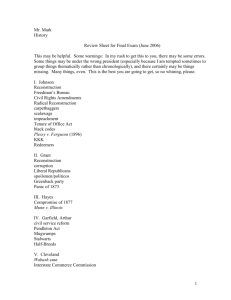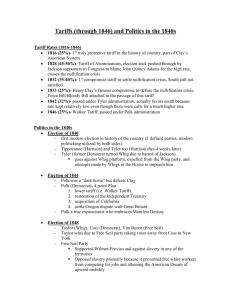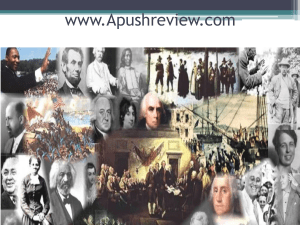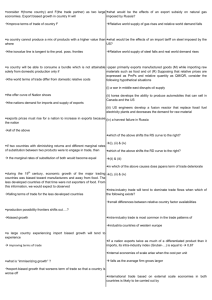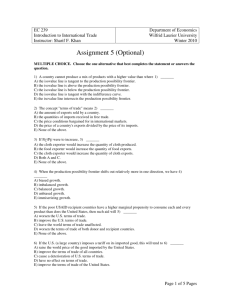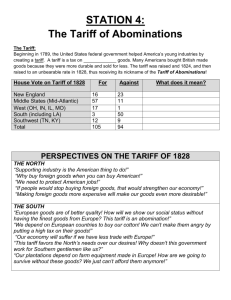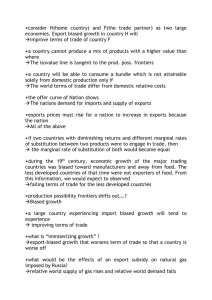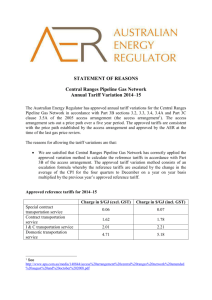Henry Clay*s American System Unit 1: Nationalism v. Sectionalism
advertisement
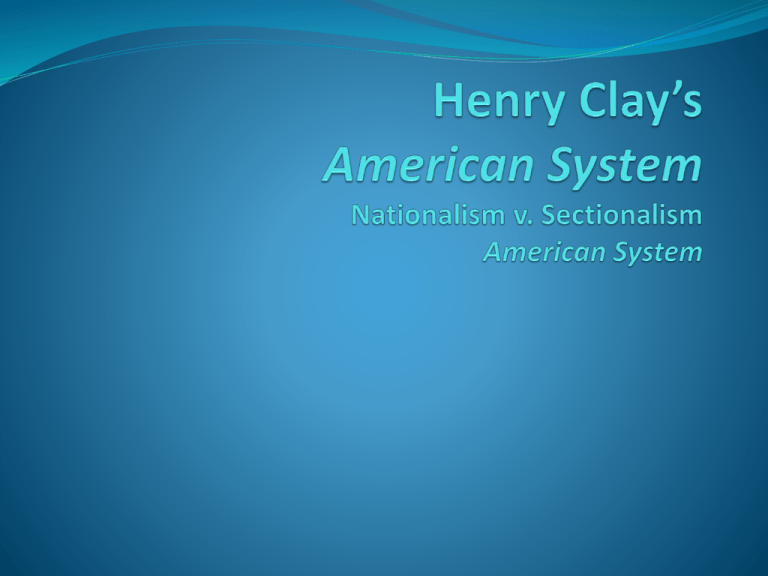
Nationalism vs. Sectionalism VS. What is happening today? Vocabulary American System & Henry Clay Nationalism Sectionalism National Road Erie Canal Tariff Nullification National bank American System: Introduction In 1815, President James Madison presented a plan to Congress that would help unite the different regions of the United States. President Madison wanted to create a self-sufficient country that would maintain a stable economy, and develop a united country. Three major points of the American System: 1. Developing transportation systems 2. Establishing a protective tariff 3. Resurrecting the national bank Intro video Found at: http://youtu.be/jJppEhwRsVQ American System: Definition What is Henry Clay’s American System? House Speaker, Henry Clay coined the term “American System” in 1815, after President Madison created a plan to unite the Northern and Southern economies. Think about it… Task: (PUT IN NOTEBOOK) Write down a paragraph that answers the following question. Make sure you include at least three different methods of economic reform. Include at least one supporting statement for each method of reform. 1. Imagine you are currently the President of the US, and you have to create a plan for economic reform. How would your American System help the US become independent of other nations? Make sure that you are creating a system that is fair and beneficial to all regions of the US, and explain how your reform plan helps the US economy. North Economy: +/ Northern Economy: Strengths 1. The north had just experienced an Industrial Revolution, and was producing manufactured goods. 2. New methods of transportation that brought goods to and from the manufacturing north. 3. A new, national currency that enabled the north to trade with the south and west. Northern Economy: Weaknesses 1. Poor soil, low crop production, few livestock. Southern/Western Economy: +/ Southern/Western Economy: Strengths 1. Good and rich soil for plantation farming. 2. Increased slavery, increased productivity. 3. Use of the Mississippi River for transportation of goods between the north and south economies. • Southern/Western Economy: Weaknesses 1. No factories for manufacturing goods. 2. Heavy, intense labor needed to run the plantations smoothly in the south. The American System STEP 1: A tariff (a tax on imported goods) Made European goods more expensive Encouraged Americans to buy cheaper products made in America Made the country money, used for national improvements Developments include… 1816- President James Madison proposes a tariff that would tax all imported foreign goods. 1. The proposed tariff would help the American manufacturing economy become more competitive with the foreign markets, because the imposed tariff would offset the prices of foreign/domestic goods. 2. The north encouraged the tariff because it would improve the their economy and increase total profits. 3. The south and west discouraged the tariff because they would have to pay more for the same products. Step 2: A National Bank Stabilize/ strengtrhen the currency and rein in risky banks Developments include… 1816- The Second Bank of the United States (BUS) was approved for a 20-year term by the Congress. 1. The bank charter would establish a national, guaranteed currency, that would improve national and regional trading of goods and services. 2. The national bank idea had been revived from the presidency of George Washington, and had become vastly popular among all regions of the country. 1816- James Monroe (VA) is elected US President. 1. Begins a new presidency, “Era of Good Feelings!” Step 3: Transportation Build many more roads and canals Paid for by the money made from the tariff Developments include… 1807- Robert Fulton’s Clermont makes its maiden voyage, 150 miles from New York City to Albany. 1811- Construction of the National Road begins between Cumberland, MD and Vandalia, Il. 1825- Erie Canal opens a 363-mile waterway that connects the Hudson River to Lake Erie. 1825- First steam locomotive was used to transport goods across different regions of the country. 1838- National Road opens to the public, tolls are required to help offset construction costs. Venn Diagram: North v. South Task: (PUT IN NOTEBOOK) Compare and contrast the northern and southern economies using a Venn diagram. Use a (+) symbol for a positive comparison, and use a (–) symbol for a negative comparison. You should include at least three differences and three similarities between the two economies. Make a concluding statement about the similarities and differences of the two economies. Share the conclusion with the class or small group.


